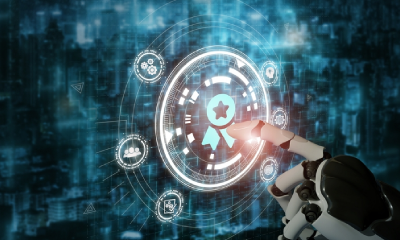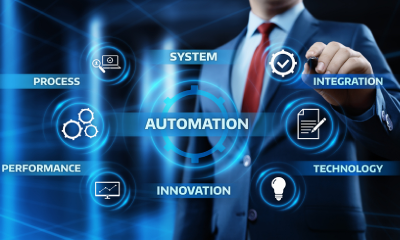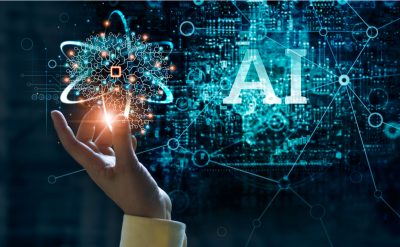Highlights:
- Hyper-automation is a term used to describe the integration of advanced technologies such as artificial intelligence (AI), machine learning (ML), robotic process automation (RPA), and other forms of intelligent automation to automate complex business processes end-to-end.
- Due to the growing interest in this technology phenomenon, Gartner anticipates that by 2024, businesses will have implemented at least three of the twenty software solutions that enable hyper-automation.
We were taught that steam engines were deployed to automate the textile industry during the First Industrial Revolution towards the end of the 18th century. The Second Industrial Revolution brought electricity and the internal combustion engine, while the Third Industrial Revolution brought digitalization and process automation around the end of the 20th century.
The Fourth Industrial Revolution is now here, bringing in robotics, the Internet of Things (IoT), and Artificial Intelligence (AI). It is a process that is compelling developed nations to engage in reindustrialization to regain their self-sufficiency in consumer goods production. Hyper-automation, also known as digital process automation (DPA) or intelligent process automation (IPA), is one of the most significant technological developments of the next several years in this new setting.
Hyper-automation is a term used to describe the integration of advanced technologies such as artificial intelligence (AI), machine learning (ML), robotic process automation (RPA), and other forms of intelligent automation to automate complex business processes end-to-end.
This process is the next phase of automation, where the focus is on automating repetitive and manual tasks and creating a fully automated system that can handle complex workflows, unstructured data, and decision-making processes.
Hyper-automation combines multiple automation technologies and tools to create a cohesive system that can work seamlessly across different functions and departments. By automating complex processes, hyper-automation can help organizations reduce costs, improve operational efficiency, enhance customer experience, and gain a competitive advantage in the market.
Hyper-automation Outperforms RPA in Every Way
Although hyper-automation tries to automate the entire process, i.e., in sizeable enterprise-level transformation, RPA employs software bots to automate specific activities. In essence, it aids in an organization’s digital transformation process.
RPA is enhanced by hyper-automation in terms of:
- The tools used are task-based and constructed on individual bots for RPA, whereas technology sequencing is used for hyper-automation.
- Internal workings: Hyper-automation is a network of technologies, platforms, and systems, unlike RPA, which is platform-specific.
- The end result: While hyper-automation produces intelligent, flexible, and efficient processes, RPA produces efficient processes.
- Future potential: Whereas automation can only be used for specialized, isolated use cases, hyper-automation can automate practically every aspect of a business.
RPA, AI, low-code application platforms (LCAP), and virtual assistants can all be used to quickly identify, evaluate, and automate as many processes as it is very practical. Gartner predicts that by 2024, businesses will have implemented at least three of the twenty software solutions that facilitate hyper-automation, due to the increasing interest in this technology phenomenon.
How Can Hyper-automation Transform Business in 2023
You might wonder what makes hyper-automation such hype. Well, it has the potential to revolutionize business operations tremendously. According to CRM Consultant, GlobeNewswire estimates that the present value of the worldwide hyper-automation market is USD 549.3 million, with a predicted CAGR of 22.79% to reach USD 2,133.9 million by 2029. Here are seven ways how hyper-automation will transform business in 2023:
Faster and more accurate decision-making
Hyper-automation will enable businesses to make faster and more accurate decisions by automating the analysis of large amounts of data. AI and machine learning algorithms can analyze data and provide insights to decision-makers, enabling them to make more informed decisions. This will improve operational efficiency, reduce errors, and increase the speed of decision-making.
Hyper-automation guarantees an implementation path devoid of errors. In addition, it provides superior analytic solutions that can be utilized to gain insights and comprehend organizational trends on a broader scale. Executives can monitor and distinguish what is successful and what is not.
Improved customer experience
Hyper-automation automates complicated business operations. Hyper-automation will transform the way businesses interact with customers. With the help of AI-powered chatbots, companies can provide personalized and efficient customer service around the clock. This will lead to improved customer satisfaction, loyalty, and retention.
To improve CX, you can also obtain insights into customer behaviors and analyze agent interactions, the number of complaints, and the frequency of first-time problem resolution, among other things.
Reduced costs
Hyper-automation will enable businesses to automate repetitive tasks like data entry, invoice processing, and report generation. This will reduce the need for human intervention, thereby lowering labor costs. Additionally, automation reduces errors and increases efficiency, lowering operational costs.
According to Gartner, combining hype-automation technologies with redesigned operating processes will reduce costs by 30% by 2024.
Accelerate the pace of innovation
Hyper-automation serves as the key driver for digital transformation. Low-code platforms allow businesses to design and improve processes, replace outdated systems without fear of data loss, and deploy new apps within weeks.
Establish a centralized truth source
The new hybrid cloud standard has made system integration a requirement for digital transformation. The concept of hyper-automation is predicated on the integration of software and processes. This results in seamless exchanges between on-premise equipment and data storage. Consequently, this architecture enables systems to connect and communicate easily, resulting in enhanced data accessibility through consolidation, even in a highly diverse environment.
Improved compliance
Hyper-automation will help businesses comply with regulations and standards by automating compliance-related tasks like data privacy and security. This will reduce the risk of non-compliance, fines, and reputational damage.
Competitive advantage
By utilizing hyper-automation, businesses can obtain a competitive advantage by responding to changing market conditions and innovating more rapidly than their competitors. From basic automation to enhanced artificial intelligence and machine learning, organizations must reach hyper-automation and deep learning.
Conclusions
With the increased usage of low-code/no-code tools, digital twins, and mass-market robotic process automation, the hyper-automation strategy is predicted to reach new heights and impact the corporate world in 2023. By merging AI with automation, businesses can focus on more inventive solutions that reliably satisfy ever-changing market demands.














